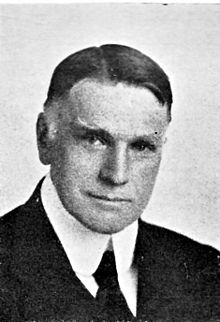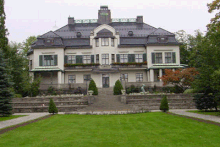Henrik Bull
Henrik Bull | |
|---|---|
 Henrik Bull | |
| Born | 28 March 1864 Christiania,Norway |
| Died | 2 June 1953(aged 89) Oslo,Norway |
| Nationality | Norwegian |
| Occupation | Architect |
| Spouse | |
| Parent | Georg Andreas Bull |
| Relatives | Ole Bull(uncle) Knud Bull(uncle) Edvard Hagerup Bull(cousin) Schak Bull(cousin) |
Henrik Bull(28 March 1864 – 2 June 1953) was a Norwegian architect and designer. Among his works are the Paulus Church atGrünerløkkain Oslo, theNational Theater,theHistorical Museum in Oslo,and the Government Building.[1]He also designed coins forNorges Bank,and participated at the Kristiania Jubilée exhibition atFrognerduring 1914.[2]He directed theNorwegian National Academy of Craft and Art Industryfrom 1912 to 1934.[3]


Early and personal life
[edit]Bull was born inChristianiaas the son of architectGeorg Andreas Bulland Emilie Constance Hjelm.[2]His father was among the major architects in the country, was chief building inspector in Christiania for forty years, and performed surveying and archeological research.[4]Bull married actressMette Marie Berntsen Wangin 1905. He was a nephew of violinistOle Bull[2]andKnud Bull,and a first cousin of judge and politicianEdvard Hagerup Bulland architectSchak Bull.[5]
Works
[edit]Churches
[edit]Bull's first major commission was thePaulus Churchin Kristiania.[2]This church, built inGothic Revivalstyle, is located atGrünerløkka,and was finished during 1892.[3]He also did research work on the oldstave churches.[2]His Uvdal Church was built inromanticstyle, and finished during 1893.[3]Another of his works was the Åmot Church at Rena, a timber church.[2]

Monumental buildings
[edit]Bull designed three of the most important new buildings in Kristiania about 1900.[3]TheNational Theatre(1891-1899) is regarded as one of the most successful buildings in Norway from thehistoricismperiod.[2]The Historical Museum (1902) was based on deceased architect Karl August Henriksen's draft from 1890.[3]The Government Building (1904) was based on a draft by architect Stener Lenschow from 1887/1891.[3]
Jubilée exhibition 1914
[edit]Bull was responsible for the buildings at the1914 Jubilee Exhibitionin Kristiania. He also designed several of the exhibition buildings, including thebridge,theMachinery Hall,theIndustry Hall.The buildings were demolished after the exhibition.[3]

Norway US embassy residence
Design work
[edit]- Bull also designed furniture and other utilitarian articles. One of his works, an exclusive dining room set, is located at theNorwegian Museum of Cultural HistoryatBygdøy.His most widespread works were the coins designed forNorges Bankin 1907 and in 1923-1924.[2]
- TheArt NouveauorJugendstyleresidence of theUnited States Ambassador to Norway,called the Villa Otium, was designed by him.[6][A]
See also
[edit]Bibliography
[edit]Footnotes
[edit]- ^The building was inspired by Russian architecture, and was built forHans Andreas Olsen,who had encountered the style when he was the Consul General for Norway atSt. Petersburg, Russiawith his wife Ester, the niece ofAlfred Nobel."Ambassador's Residence in Oslo;" Villa Otium "".U.S. Department of State.Archived fromthe originalon 15 October 2011.Retrieved9 November2011.
Endnotes
[edit]- ^Henriksen, Petter, ed. (2007)."Henrik Bull".Store norske leksikon(in Norwegian). Oslo: Kunnskapsforlaget.Retrieved16 April2009.
- ^abcdefghIndahl, Trond."Henrik Bull".InHelle, Knut(ed.).Norsk biografisk leksikon(in Norwegian). Oslo: Kunnskapsforlaget.Retrieved16 April2009.
- ^abcdefgSteigan, Geir Tandberg (2001)."Henrik Bull (1864-1953)"(in Norwegian). Arc!.Retrieved21 April2009.
- ^Torvanger, Åse Moe."Georg Andreas Bull".In Helle, Knut (ed.).Norsk biografisk leksikon(in Norwegian). Oslo: Kunnskapsforlaget.Retrieved20 April2009.
- ^Bratberg, Terje (2007)."Den trønderske slekten Bull".In Henriksen, Petter (ed.).Store norske leksikon(in Norwegian). Oslo: Kunnskapsforlaget.Retrieved4 April2009.
- ^"Ambassador's Residence in Oslo;" Villa Otium "".U.S. Department of State.Archived fromthe originalon 15 October 2011.Retrieved9 November2011.
